Architect Hans WOLFF-GROHMANN: 2 letters & 2 telegrams
Description
– See more pictures below! –
They bid on two signed letters and two telegrams of Designers, musicians and architects Hans Wolff-Grohmann (1903-2000).
Aimed at the pianist, composer, writer and music critic Erwin Kroll (1886-1976).
1.) Letter Berlin, February 6, 1951, with belated congratulations on your 65th birthday. Birthday and invitation to a visit. Signed "Dr. Wolff-Grohmann". Scope: 1 p. (14.8 x 21 cm).
Enclosed is the envelope (with postmark Berlin-Schmargendorf, February 8, 1951). -- Letter and envelope with printed sender information "Hans Wolff-Grohmann // Architect BDA // Berlin-Dahlem Max-Eyth-Straße 3."
2.) undated congratulations card for Christmas and New Year, signed "Yours, Sabine and Hans Wolff-Grohmann" (in the handwriting of Hans Wolff-Grohmann). Format: 10.8 x 15.3 cm.
3.) Telegram from the Deutsche Bundespost dated January 3rd February 1956: Congratulations on your 70th birthday Birthday of Sabine and Hans Wolff-Grohmann. Format: 14.8x21cm.
4.) Jewelry telegram (Motif: Lovis Corith: Bouquet of flowers) from 3. February (no year specified), congratulations on the birthday of Sabine and Hans Wolff-Grohmann. Format: Folded A4 sheet.
Condition: 1.) Letter slightly wrinkled, envelope stained and damaged. 2.) stained, with corner crease. 3.) browned. 4.) stained. bittPlease also note the pictures at the end of the item description!
Internal note: Kroll 12
Pictures
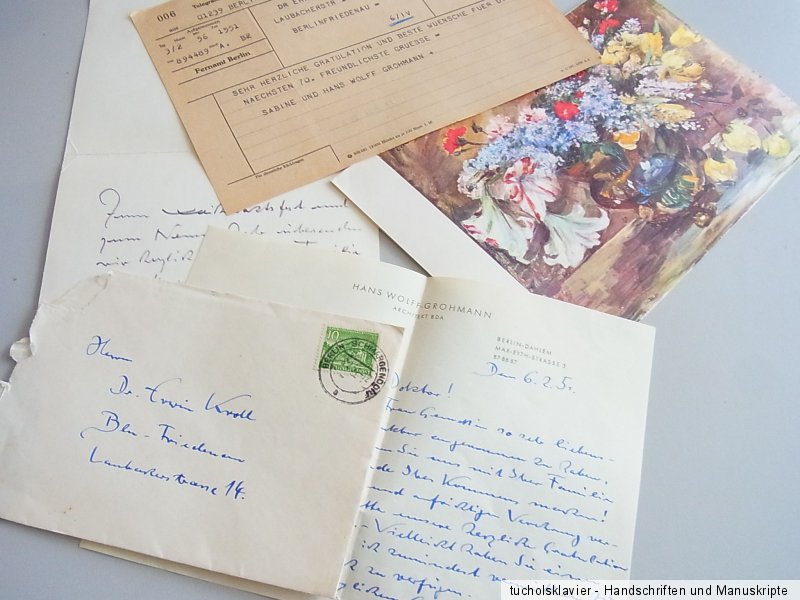
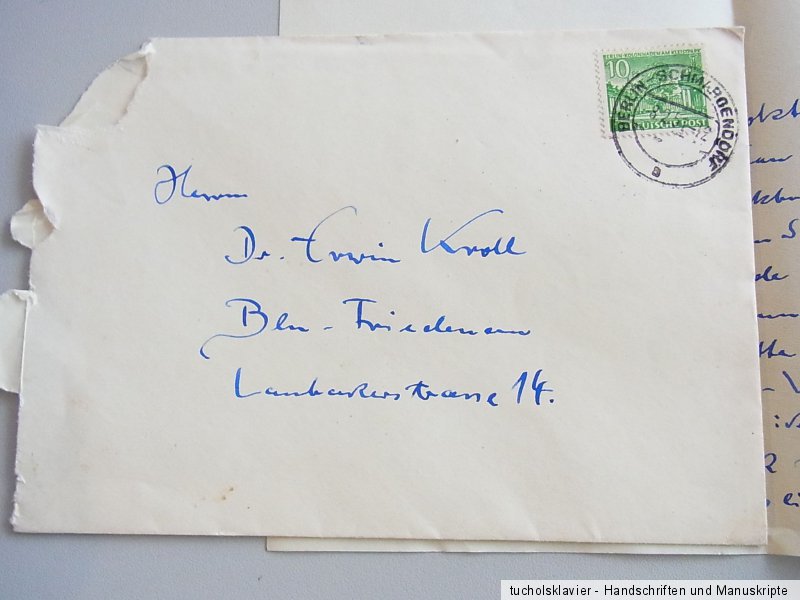

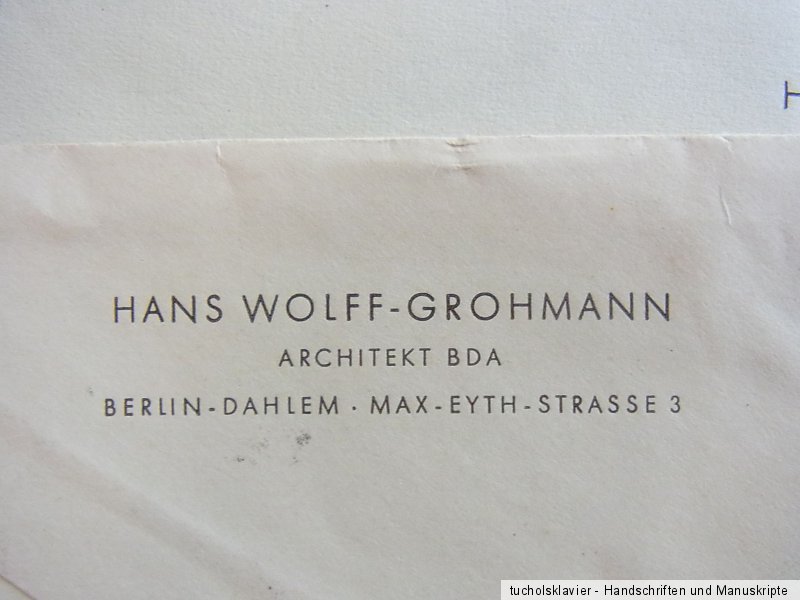
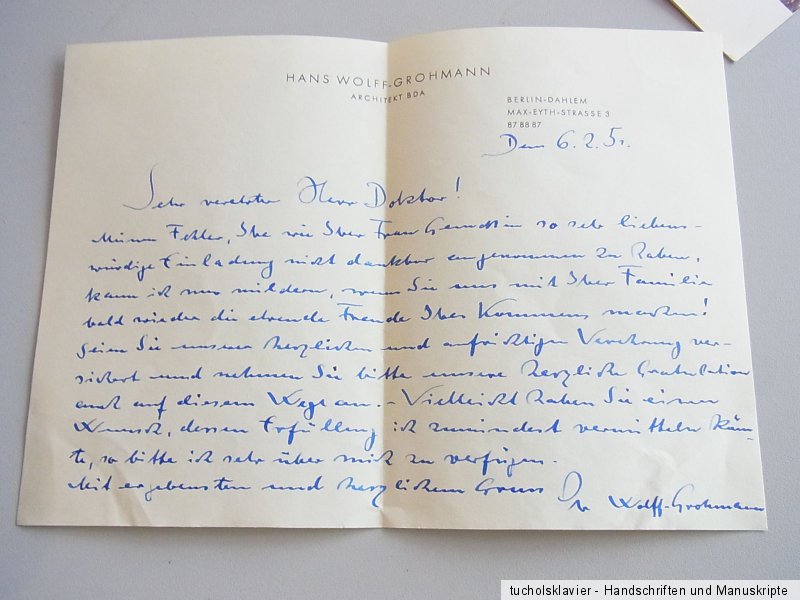
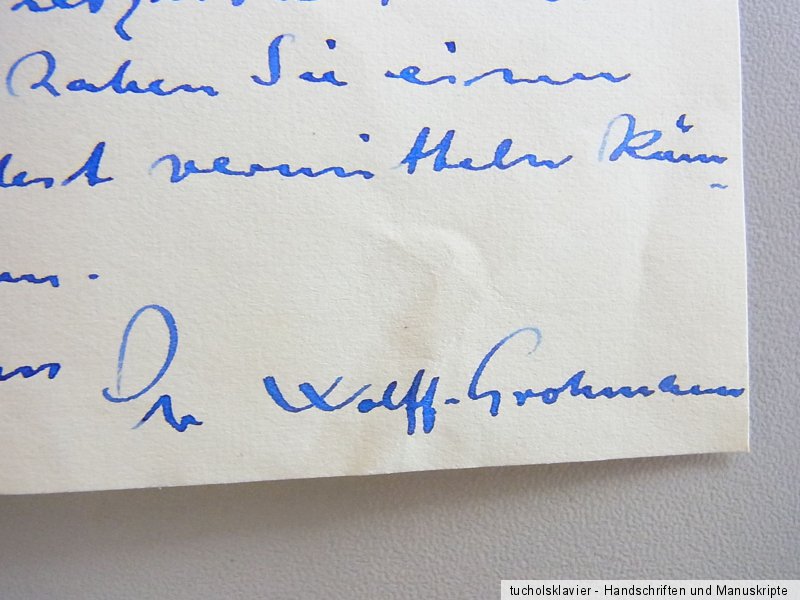


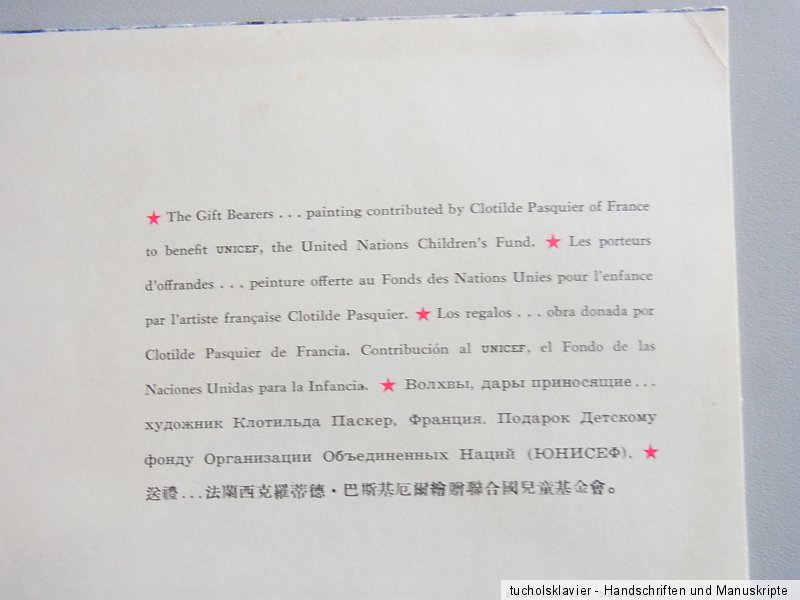
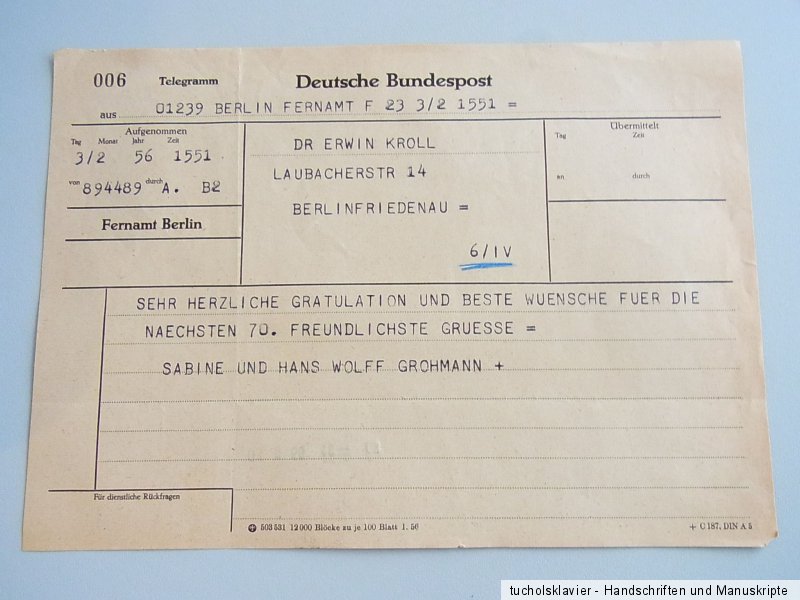
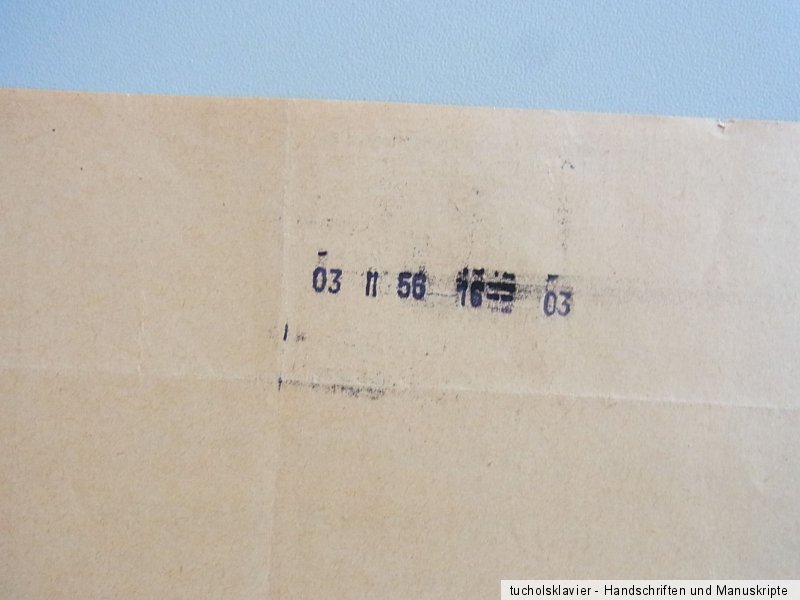

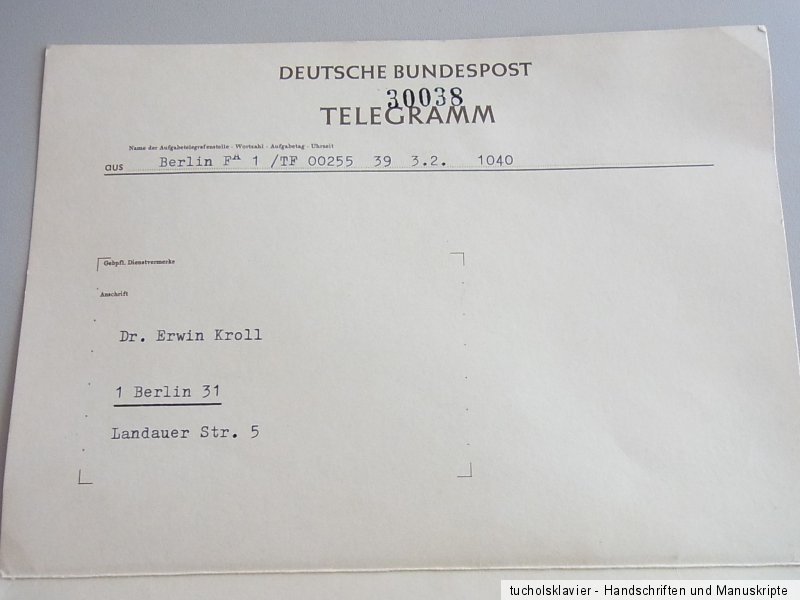
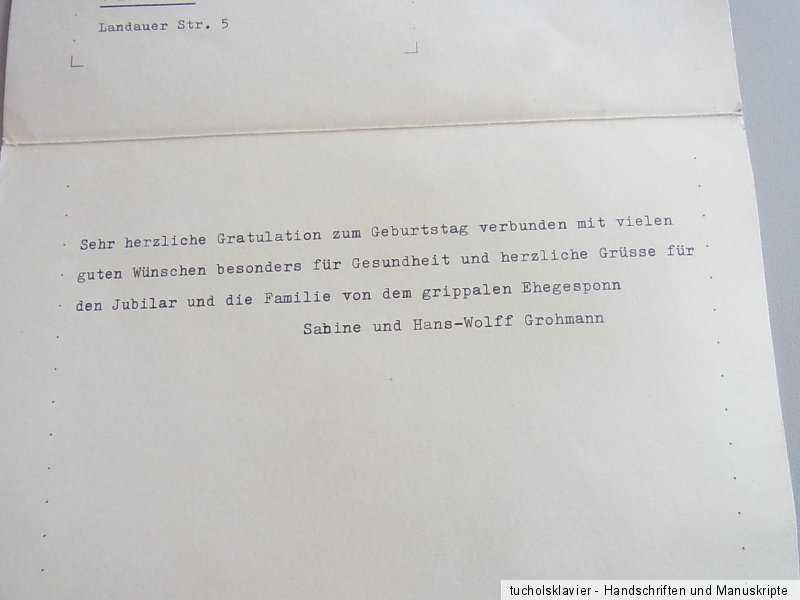

TRIXUM: Mobile-optimized auction templates and image hosting
About Hans Wolff-Grohmann and Erwin Kroll (source: wikipedia):
Hans Wolff Grohmann (*4. April 1903 in Berlin-Tiergarten; † 15. January 2000 in Berlin-Dahlem) was a German designer, musician and architect of the modern era who was able to realize many designs in the Berlin area. There are also buildings by Wolff-Grohmann outside of Berlin and abroad.
Childhood and youth: Hans' father, Rudolf-Anton Wolff, grew up on Bellevuestrasse in Tiergarten in the house of an extremely upper-class uncle. His grandfather was the commercial councilor Friedrich Wilhelm Wolff, a co-founder of the Allianz insurance company and other companies. The maternal grandfather, Wilhelm Grohmann, came from the Salzburger Land and was an engraver, royal librarian at the University of the Arts and librarian at the Berlin Artists Association in Berlin, as well as an avid private collector of graphics.
In 1901, Wolfgang was born as the first son of the Wolff family, and in 1903 Hans Heinz Wolff was born. Hans spent his childhood in the Tiergarten area, where his parents lived on Magdeburger Straße; In 1908 they moved to Prinzregentenstrasse 83 in Berlin-Wilmersdorf.
The young Wolff-Grohmann had his first artistic experiences during several visits to an uncle, Reinhold Grohmann, who worked as a talented painter in the artist Arthur Kampf's studio at the University of the Arts (then United State Schools for Fine and Applied Arts). Hans found further inspiration for engaging with art from visits to museums with his mother and from the collections of art magazines and knick-knacks. When we traveled together, his mother gave him his first understanding of urban development experiences through attentive observation of landscapes and buildings, especially churches. Hans also came to large exhibitions and musical events. This diversity meant that he became well versed early on in individual styles in both building construction and interior design, including ceramics and porcelain.
A childhood experience gave rise to Wolff-Grohmann's constant interest in theater, stage sets and design. Starting in 1912, he and his big brother and friends built their own model theater with Allen the artistic and technical equipment, including lighting, and he even constructed a functioning revolving stage for it. With the help of purchased theater puppets and decorations, performances of well-known dramas in their own adaptations (Faust, Maid of Orléans, etc.) took place on special family occasions - the theater and the stage accompanied Hans throughout his life. The theater model was even presented to the public in a former exhibition hall at the Zoological Garden as an example of handicraft work by a group of students.
Hans received his school education at the Treitschke-Realschule, today's Friedrich-Ebert-Gymnasium. – According to what his parents told him, it was clear early on that he “wanted to be a Baumeista” (his own words).
Like many children from the beginning of the 20th century. During the 19th century, Hans often went on vacation to visit relatives or friends in other cities such as Hamburg, Munich, Travemünde, Arnstadt or in the countryside, including Zinnowitz, Reuthen Castle near Spremberg or Berchtesgaden.
Hans Wolff-Grohmann married Sabine, née Froeschke, in 1939 and they moved into their own apartment. The couple had two children – Reinhold and Thomas.
Since his mother's early death (1922), Hans had the double surname Wolff-Grohmann, but he only had this documented shortly after the end of the Second World War.
Hans Wolff-Grohmann was a member of the Association of German Architects.
Artistic development
1920 to 1932: After attending school, Wolff-Grohmann learned the profession of bricklayer in a small construction shop. This was followed by a short course of study at the Municipal Crafts and Building Trades School, after which Hans continued his artistic training with Alfred Grenander and Bruno Paul at the United State Schools for Free and Applied Arts. The principle of complex designs “from the knife to the gutter”[1] was taught by his teachers and adopted by the next generation. The first architectural designs were created during his studies. After training in Berlin, he began his work designing modern wooden furniture for the Erdmannsdorfer Möbelfabrik in Schreiberhau, then (around 1930) he created steel furniture for the Thonet company. During this time, Wolff-Grohmann also worked on lamp designs and complete interior furnishings. He carried out his first work with Hans Jessen (collaboration on the design for a community center in Dahlem), with Emil Schaudt (execution of a conversion project for the Kaufhaus des Westens) and as a freelancer with Harry Rosenthal. After Wolff-Grohmann took part in a competition for shop fittings for the Blüthner company's three-story sales store on Kurfürstendamm (1929) and won first place. After winning the prize, he carried out the construction as his first work in the field of architecture.
During the years of the global economic crisis there were hardly any orders for architects, so Wolff-Grohmann went to relatives in Jeverland, first to Wiarden, then to Jever and Oldenburg. He worked as a young farmhand in agriculture and did all the work that needed to be done. At the same time, he continued to develop his joy of making music and used the time to obtain his organist exam. The art of playing the organ always remained his passion, and he performed several times at church concerts. He later played this music privately on an electronic home organ.
However, his main focus was on architecture. After Wolff-Grohmann initially chose traditional models for his buildings, he soon found his own style with cubist and colored elements as well as the use of modern materials.
In 1929, Wolff-Grohmann and Alfred Gellhorn, now working as a freelancer, took part in the competition for the urban design of Alexanderplatz; however, their draft was not adopted. From 1932 he worked for the architects Hermann Muthesius and Peter Behrens in Berlin. He was also able to work under Alfred Grenander on the design and construction of Berlin's Hallesches Tor subway station and the Dennewitzer Straße subway overpass.
General view of the post office in Berlin-Mitte, built according to Wolff-Grohmann's plans
1933 to 1945: During the years of National Socialism in Germany, Wolff-Grohmann got a job in the Reich Postal Ministry, where he worked under the direction of Ministerialrat Georg Werner together with nine other architects. During this time, the plans were drawn up for the post offices at the Nordbahnhof in Berlin-Mitte (1934–1935), at the Mönckebergdamm in Hamburg (1935–1939), for the radio transmitters on the Brocken in the Harz Mountains and numerous other functional and residential buildings. He was also involved in planning for an expansion of the Reich Postal Ministry and a diesel hall in Zeesen, which, however, were not implemented. At the same time, he designed basic types of concert halls, department stores, hotels, churches, museums and bridges. Before the end of the war, Wolff-Grohmann became self-employed again and, together with Heinrich Zeller, drew up reconstruction plans for destroyed settlements and cities such as Wittstock, Luckau, Luckenwalde and Spremberg. In 1941, Wolff-Grohmann was drafted into a barracks in Strausberg for military service, but Zeller obtained an exemption for him. However, he then had to deal with the expansion of air raid shelters and an underground bunker.[1] From 1943 he traveled to Garmisch-Partenkirchen with his wife at the invitation of his painter friend Rolf Cavael. There the family also experienced the end of the war with the arrival of a US Army tank unit.
1945 to 1950: After the war, Wolff-Grohmann set up an architectural office in Garmisch-Partenkirchen and received contracts from the Munich company Löwenbräu for the interior design of restaurants with the specification “in the true Bavarian Baroque style”. He managed to secure his livelihood by simultaneously designing and building sets, costumes and working as a lighting technician at the Garmisch-Partenkirchner Kammerspiele. His wife was also able to earn some money as a childcare worker for an American major. Hans Wolff-Grohmann took part in new competitions in his hometown of Berlin at an early stage, but remained in Garmisch-Partenkirchen until 1950. The family then moved back to Berlin to the in-laws' house on Max-Eyth-Straße.
While still in Garmisch-Partenkirchen, he developed an urban development solution around the zoo in Berlin[2], in which new commercial buildings played a primary role. The design primarily intended to retain the historic street layout and the so-called Berlin eaves height (22 m).
1951 to 2000: Through an exhibition of his previous works (July 1951 in Berlin-Charlottenburg), Wolff-Grohmann became better known and gained contacts with new clients. In addition, he was commissioned by the conductor Ferenc Fricsay as a set and costume designer for the performance of Duke Bluebeard's Castle at the Theater des Westens (as the German Opera had not yet been rebuilt).
Wolff-Grohmann also had commissions again as a freelance architect, often as a result of winning competitions, such as B. Housing estates in Berlin-Spandau, Berlin-Lankwitz and Berlin-Charlottenburg. Around 4,000 apartments were built in these buildings planned by Wolff-Grohmann by the end of the 1950s. Of the other designs, the realized building complex consisting of a cinema and hotel for the French sector at the time (L'Aiglon) is particularly worth highlighting.
In the early 1950s, he was also given responsibility for the restoration of the heavily damaged Schinkel Paulskirche in Gesundbrunnen. Because the construction files were outsourced to the Soviet Union at that time and were therefore not available, Wolff-Grohmann's work was based on Schinkel's ideas, but parts of the ceiling and the entire interior had to be redesigned by him. Completion took five years, mainly due to financial problems.
In 1965/1966 he took part in an architectural competition for the construction of the German Archaeological Institute in Istanbul. His design took first place, but was not implemented due to a general construction ban on institute buildings imposed by the Turkish side. In 1971, his third-place design for the building of the German School in Rome was purchased by the client.[3] In 1975, his plan for the building in Athens then called the Cultural Institute – now the Goethe Institute – came second. Since another architect's winning design could not be implemented due to his sudden death, the Federal Building Directorate assigned the building to Wolff-Grohmann based on the winning design, although a few small changes were allowed to be made.
In earlier years, Wolff-Grohmann had already submitted concrete plans for a general nursing home in Berlin-Charlottenburg. However, after the Berlin Senate sold the site to the Jewish community, plans were redesigned to become a Jewish retirement home with an integrated synagogue, which was then built according to his design in 1981.
Competition projects (selection)
Designs of buildings
Town Hall (1920s),
High-rise variants at Friedrichstrasse train station (1922),
Glass and porcelain shop for the Kaufhaus des Westens, 2. Price,
a church building (around 1928),
Commercial building for the Mannesmann company on Friedrichstrasse (1930),
Nietzsche House and Nietzsche Museum (both 1930),
Olympic Village (1935/36),
Exhibition hall including interior decoration for the post office at the Berlin Radio Exhibition (1938),
European Union in Frankfurt/Main (1947),
Cinema in Bad Reichenhall (1949),
Department store in Kiel (around 1950),
Retirement home in the Tiergarten (1951) on an area between Seydlitzstrasse, Lehrter and Invalidenstrasse,
Building for the Berliner Bank on Hardenbergstrasse (1951) in Berlin-Charlottenburg,
Office and commercial building for Allianz Insurance on a site in Augsburger/Joachimsthaler Straße/Kurfürstendamm (approx. 1952); one of two submitted variants was purchased by the sponsor,
a Protestant church (approx. 1952), as the first considerations for a new building instead of the Paulskirche,
Allianz insurance building in Bremen (1953),
Ideas for the Schöneberg southern area (1953),
Redesign of the Nollendorfplatz subway station (1954) (2. Price),
Beethoven Hall in Bonn (1954),
Paul Schneider Protestant community home in Berlin-Lankwitz (1955/56),
Reconstruction plans for the German Opera in Berlin (1955),
Museums in Berlin-Tiergarten,
Extension building for the Free University in Berlin-Dahlem (1958),
Apartment buildings in Berlin-Schöneberg (Badenallee),[4]
German Archaeological Institute in Istanbul (1965/66).
Designs of monuments
National Monument for the Battle of Tannenberg (1927),
a warrior memorial in Kiel, together with Rolf Szymanski (1953), (1. Price),
Monument to Henry the Navigator in Sagres, Portugal (1955), together with the sculptor Bernhard Heiligener (not accepted),
Memorial for the Jewish community in Lemgo (1986), joint work with the sculptor couple Matschinsky-Denninghoff.
Realized buildings by Wolff-Grohmann (selection)
Berlin
Post office in Berlin-Mitte, Am Nordbahnhof street, completed 1935–1938,
striking detail are large rectangular travertine slabs;
Special feature: Wolff-Grohmann also created the design for the invitation card for the topping-out ceremony,
Amplifier office disguised as a residential building and a bunker at Stallupöner Allee 19–23 (around 1934):
Buildings with Allen exterior designs (windows, doors, lighting); This transmitter system continued to be used by the post office after 1945, and at some point it became the property of the city of Berlin. Now the SFB used this facility and also the successor broadcaster rbb. The broadcasting station was only switched off in 2006. The buildings, which had been vacant for several years (photos under Commons), were demolished in 2012 by a private investor in favor of new residential buildings.
The former L'Aiglon cinema
L'Aiglon (French: little eagle; also nickname of Napoléon) –
a U-shaped cinema and hotel building on the former site of the French armed forces (today: Julius-Leber-Kaserne) at Kurt-Schumacher-Damm 121,
1953/1954 new building in place of a destroyed building complex; in operation until 1993. From 1995 to 2006, the cinema room was used as a rehearsal hall for the Army Music Corps 400 (today: Bundeswehr Staff Music Corps) after its relocation to Berlin and was also reconstructed during this time in accordance with monument standards.[5][6]
Residential buildings on Lepsiusstrasse, Berlin-Steglitz (before 1957),
School building for a comprehensive school in Berlin-Hermsdorf (1957),
Residential buildings on Gallwitzallee, Berlin-Lankwitz (1956–1958),
Residential houses on Hohenzollerndamm in Berlin-Wilmersdorf (before 1959),
Residential buildings at Motzstrasse 47–49 (around 1961),
School building for a primary school in Berlin-Lankwitz on Kefferbrinkweg (1962),
Residential buildings Taldorfer Weg, Berlin-Wittenau (1962),
Tegel sports hall in Hatzfeldallee (1961–1963),
Nurses' home in Berlin-Tempelhof on the grounds of the Wenckebach Hospital (1964),
an 18-story high-rise on Handjeryplatz (1962–1968),
Falkenberger Chaussee settlement in Berlin-Spandau (1964),
Residential buildings for the French military administration in Berlin-Wedding, Londoner Straße (around 1967),
Apartments in the Amalienhof in Berlin-Staaken (1968),
Residential complex for the Deutsche Bundespost Am Rupenhorn 7–8 (1973–1976), so-called terrace houses.
Jewish retirement home with synagogue
Jewish retirement home (Leo Baeck Synagogue) in Charlottenburg, Herbartstrasse 26 (1980/1981).
For the entrance hall to the synagogue on the ground floor, six columns from the destroyed synagogue of a retirement home on Iranische Strasse were used.
In Germany outside of Berlin
Post office in Hamburg (1936–38),
Jewelry shop in Garmisch-Partenkirchen (1947).
Abroad
Goethe Institute in Athens (1975).
Working outside of architecture (selection)
Design drafts
Interior design for a private apartment in Berlin-Charlottenburg (early 1920s),
Armchairs, ceiling and wall fluorescent lamps for some Berlin architects (1924 to 1930),
Steel chair and steel table for Thonet (both 1930),
Punch bowl, champagne cooler (1930),
for the tool machine factory (WMF) (1930),
Interior redesign of the theater on Nollendorfplatz (1955),
Colored facade designs (Grenander-Allee, residential building at Kottbusser Tor, Bismarckstrasse, Rückertstrasse, Gitschiner Strasse; 1974 to 1983), largely implemented
Stage designs
According to his own account, Wolff-Grohmann made around 200 stage designs, including:
in Bavaria for operas, ballet and drama (1945 to 1949), voluntary,
for Maria Stuart by Friedrich Schiller (1947),
in Berlin for Knight Bluebeard's Castle (1951).
painting
“Abstract” –
Homage to Rolf Nesch;
Hans Wolff-Grohmann, 1985
The artist Wolff-Grohmann also began to paint pictures after his early landscape experiences and travel impressions. His stay in the house of the painter Rolf Cavael in Garmisch-Partenkirchen inspired him to create his own abstract paintings. Almost 100 works worth seeing were created, including:
Foehn over blue mountains,
Zeitgeist,
friendly steadiness,
multiple abstractions.
Further works (selection)
Design for a private airfield on Lake Geneva in Switzerland (1951)
Exhibitions and honors
The Charlottenburg Art Office organized its first exhibition in July 1951 with the title Hans Wolff-Grohmann, Architect, Painter, Set Designer.
The extensive architectural work of Wolff-Grohmann (and Gerhard Siegmann) was honored in an exhibition at the Berlin Cultural Forum in the summer of 1999, which was then shown at the Science Center in Bonn that same fall.
The 95th Hans Wolff-Grohmann celebrated his birthday with family members and numerous friends in Berlin and Salzburg.
In 2003, on the occasion of the 100th On the architect's birthday, a large part of Hans Wolff-Grohmann's works were shown to the interested public in photos and models in an exhibition in the Romstedt Gallery in Potsdam.
Miscellaneous
The paintings, photos, project designs and models of Wolff-Grohmann's life's work were mostly given to various art institutions during his lifetime, namely the Märkisches Museum, Bauhaus Archive Berlin, State Archives Berlin, Art Library of the State Museums in Berlin, Stiftung Stadtmuseum, Berlin Gallery (pictures).
Erwin Kroll (*3. February 1886 in German Eylau; † 7. March 1976 in Berlin) was a German pianist, composer, writer and music critic. Like his friend Otto Besch, Kroll was an East Prussian composer.
Life: Around 1900 Kroll came to Königsberg i. Pr. and attended the Royal Hufengymnasium with Otto Besch. He studied philology and music at Albertus University. He received his doctorate from ETA Hoffmann, who has always been revered in Königsberg. phil. and went into school service.
In 1919 he turned entirely to music and continued his studies in Munich, which he had begun with Otto Fiebach and Paul Scheinpflug. There he found an important teacher, especially in Hans Pfitzner, to whom he later dedicated a highly acclaimed book. In addition to his studies, Kroll was an accompanist at the Munich State Opera and secretary of the Hans Pfitzner Association for German Music, which Thomas Mann had called for to be founded.
In 1925 Kroll returned to East Prussia and became music critic for the Hartungsche Zeitung, and from 1930 onwards it was its features editor. Since 1934 he worked in Berlin as a critic and music writer. After the Second World War he headed the music department of the Nordwestdeutscher Rundfunk in Berlin until 1953.
With his book, Kroll has created a monument to the (forgotten) importance of Königsberg as a music city.[3]
See also: Music in Königsberg
factories
East Prussian homeland - orchestral work
Violin Sonata in B major
Sonatina in F major
East Prussian dances
The Adebar - fantasy about East Prussian folk tunes for large orchestra
Vocal works and song arrangements
Songs for solo voices and choir songs
Fonts
Music city Koenigsberg
Ernst Theodor Amadeus Hoffmann. Breitkopf & Härtel, Leipzig 1923.
Hans Pfitzner. Three Masks Verlag, Munich 1924 .
The theater. Festschrift for the 25th anniversary of the Dortmund Municipal Theater. The theater, Berlin 1930.
Carl Maria Weber. Athenaion, Potsdam 1934 .
Music city Königsberg. Atlantis, Freiburg i. Br. 1966.
Honors
Federal Cross of Merit on ribbon (27. January 1956)
Cultural Prize of the East Prussian State Team (1960)